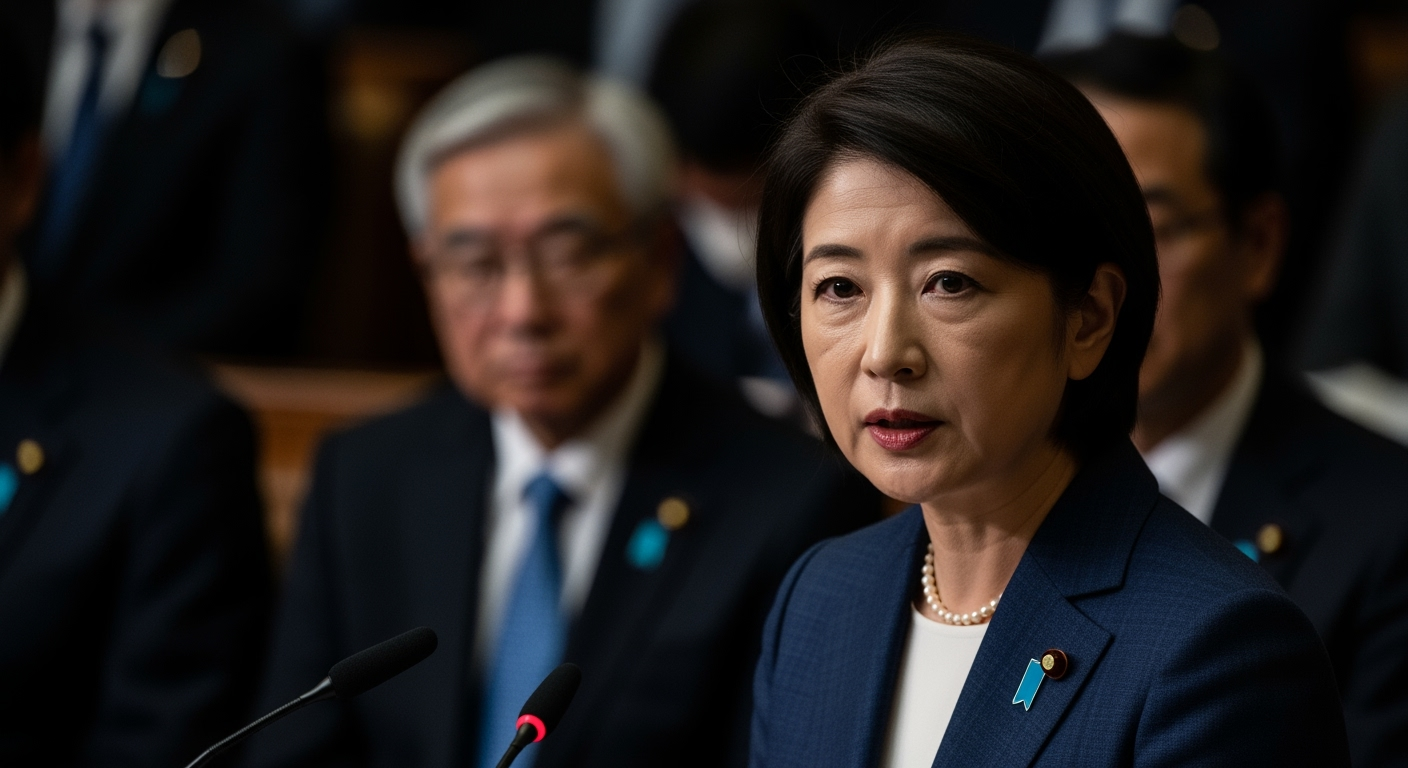Related Articles

Substandard Cable Blamed in Deadly Lisbon Funicular Crash, Raising Broad Safety Concerns




TOKYO – Japan stands on the cusp of a historic political transition as Sanae Takaichi, a staunch conservative and veteran lawmaker, is set to become the nation's first woman Prime Minister. Her path to the top office was solidified by her recent victory in the Liberal Democratic Party (LDP) presidential election and reports of a newly forged coalition with the right-leaning Japan Innovation Party, overcoming initial setbacks after a key ally departed the ruling bloc. This groundbreaking appointment promises to reshape Japan's political landscape, signaling a shift in leadership dynamics while Takaichi prepares to navigate a complex array of domestic challenges and geopolitical tensions.
Sanae Takaichi's ascent to the leadership of Japan's long-dominant Liberal Democratic Party on October 4, 2025, marked a pivotal moment in Japanese politics, making her the first woman ever to head the party. Her victory in the LDP presidential election, securing 185 votes in a runoff against rival Shinjirō Koizumi, positioned her as the presumptive Prime Minister. This triumph, however, was immediately followed by political turbulence. The LDP's long-standing coalition partner, Komeito, unexpectedly withdrew from their alliance, citing the LDP's failure to adequately address recent money scandals involving several of its members of parliament. This withdrawal left the LDP without a majority in either house of the Diet, casting a shadow over Takaichi's immediate path to premiership.
In the wake of this political fragmentation, intense negotiations ensued to secure a new governing alliance. Reports now indicate that the LDP and the Japan Innovation Party (JIP), also known as Ishin, have broadly agreed to form a coalition government. Leaders from both parties are reportedly set to finalize the agreement, which would see the JIP supporting Takaichi in the upcoming parliamentary vote for Prime Minister. This new alignment, driven by common ground on issues such as constitutional amendment, foreign policy, and national security, provides Takaichi with the necessary parliamentary support to assume the premiership. The parliamentary vote, expected on October 21, will formally confirm her as Japan's chief executive, marking an unprecedented milestone for a nation that has historically lagged in female political representation.
Sanae Takaichi, born in Nara Prefecture in 1961, does not hail from a traditional political dynasty, distinguishing her from many of her contemporaries. Her early career included stints as an author, broadcaster, and even a drummer in a rock band, reflecting an unconventional background for a Japanese politician. After graduating from Kobe University, she gained experience through an internship in the U.S. Congress before being elected to the House of Representatives as an independent in 1993, later joining the LDP in 1996.
Throughout her political career, Takaichi became a close protégé of the late Prime Minister Shinzo Abe, who served as a significant mentor. Her political views are largely aligned with Abe's conservative agenda, earning her a reputation as a hard-line conservative and nationalist. She has often been compared to former British Prime Minister Margaret Thatcher, a figure she openly admires, leading to her being dubbed Japan's "Iron Lady". Takaichi has held several key ministerial portfolios under both Abe and Fumio Kishida's administrations, including Minister for Internal Affairs and Communications and Minister of State for Economic Security. Her consistent advocacy for a strong and prosperous Japan, coupled with a deep understanding of policy issues, has underscored her rise within the LDP.
As Prime Minister, Sanae Takaichi is expected to champion policies that largely continue the ideological trajectory set by her mentor, Shinzo Abe. Economically, she is a vocal proponent of "Abenomics," advocating for aggressive government spending and loose monetary policies aimed at stimulating growth. Takaichi prioritizes economic expansion, asserting that while fiscal prudence is important, it should not overshadow the imperative for growth. This approach signals a commitment to tackling Japan's persistent deflationary pressures and invigorating the nation's economy.
On matters of national security and foreign policy, Takaichi adopts a hawkish stance. She has consistently advocated for revising Japan's pacifist constitution to strengthen its defense capabilities and enhance its position on the global stage. Her nationalist views extend to a robust "Japan First" foreign policy, emphasizing the country's national interest. Takaichi is known for her tough stance on China and has regularly visited the controversial Yasukuni Shrine, which honors Japan's war dead, including convicted war criminals. These visits have historically drawn criticism from Beijing and Seoul, potentially complicating Japan's relations with its East Asian neighbors. While she reportedly softened her stance on future Yasukuni visits during her LDP leadership campaign, stating she would decide "appropriately," her underlying conservative approach to history and defense is likely to influence regional dynamics. Furthermore, she has called for stricter immigration controls and tighter screening of foreign investment, measures aimed at safeguarding economic security and national interests.
Despite the historic nature of her potential premiership, Takaichi faces an unenviable array of challenges, both domestically and internationally. Her administration will effectively operate as a minority government, requiring delicate coalition management and negotiation to pass legislation through a divided parliament. The LDP's loss of majority in both houses of the Diet following the 2024 general election and the 2025 House of Councillors election indicates a significant erosion of public trust, partly due to rising inflation and political finance scandals. Regaining this trust and demonstrating effective governance will be paramount for her political longevity.
Internationally, her conservative and nationalist foreign policy leanings could strain relations with key regional partners, particularly China and South Korea. While the United States remains a crucial security ally, Takaichi's emphasis on a "Japan First" approach could lead to new complexities in the alliance. Domestically, Japan continues to grapple with persistent demographic decline, an aging population, and the accompanying pressures on social security and the economy.
Takaichi's stance on gender issues also presents a complex picture. While her ascent is a symbolic breakthrough for gender representation in Japan, a nation ranking low in global gender equality indices, her personal views are largely conservative. She has opposed same-sex marriage and allowing women to retain their maiden names, aligning with traditional values. However, during her leadership campaign, she pledged to appoint more women to her cabinet and supported policies like tax breaks for childcare services, signaling a potentially more pragmatic approach to women's economic participation. The true impact of her leadership on broader gender norms remains to be seen, with analysts suggesting that while symbolic, her actions might reinforce rather than challenge existing patriarchal structures.
Sanae Takaichi's anticipated appointment as Japan's first female Prime Minister marks a moment of profound historical significance, breaking a long-standing barrier in the nation's male-dominated political sphere. Her rise reflects a powerful shift, driven by her unyielding conservative vision and astute political maneuvering in a period of unprecedented LDP vulnerability. With a new coalition forged, Takaichi is poised to lead Japan during a time of immense domestic and international flux.
Her premiership will be defined by her commitment to Abenomics-inspired economic policies, a fortified defense posture, and a firm, nationalist stance on foreign relations. However, navigating a fractured political landscape, managing a minority government, and balancing her conservative ideology with the pragmatic demands of governance will be her immediate and most formidable tests. As Japan looks to its future, Sanae Takaichi's leadership holds the potential to either usher in an era of renewed stability and strength or deepen the political uncertainties that currently define the nation. The world will be watching as Japan's "Iron Lady" steps onto the global stage, ready to forge her legacy.